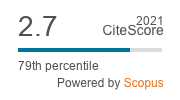A fuzzy transmission model analysis of corruption dynamics
Keywords:
fuzzy logic, corruption dynamic, fuzzy transmissionAbstract
In this study, we propose a corruption model that incorporates fuzzy transmission dynamics. We consider a population of individuals, each characterized by a corruption level ranging from 0 to 1, representing their degree of engagement in corrupt practices. The transmission of corruption is not strictly binary but rather influenced by fuzzy logic, where individuals with higher corruption levels are more likely to influence others towards corruption.
To analyze the dynamical behavior of the corruption model, we employ mathematical techniques from fuzzy systems theory and dynamical systems theory. We investigate how the corruption levels evolve over time, considering factors such as social interactions, institutional interventions, and individual tendencies.
Through simulations and mathematical analysis, we explore various scenarios and observe interesting dynamical behaviors. These include the emergence of corruption clusters , the impact of anti-corruption measures on reducing corruption levels, and the potential for corruption to spread or decline based on different initial conditions and external factors.
Our findings highlight the importance of considering fuzzy transmission dynamics in corruption models, as it provides a more realistic representation of corruption in society. This research contributes to a better understanding of the complexity of corruption and provides insights for policymakers and anti-corruption agencies in designing effective strategies to combat corruption and promote ethical behavior in society.
References
J. M. Bello y Villarino. Measuring Corruption: A Critical Analysis of the Existing Datasets and Their Suitability for
Diachronic Transnational Research. Social Indicators Research, 157(2):709–747, sep 2021.
F. Heinrich, global research, R. H. practice in Corruption, and undefined 2011. Measuring corruption. books.google.
com.
T. R. Heggedal, L. Helland, and R. Morton. Can paying politicians well reduce corruption? The effects of wages and
uncertainty on electoral competition. Games and Economic Behavior, 135, 2022.
L. A. Zadeh. Fuzzy Logic. Computer, 21(4), 1988.
H. T. Alemneh. Mathematical Modeling, Analysis, and Optimal Control of Corruption Dynamics. 2020, 2020.
S. Athithan, M. Ghosh, and X.-z. Li. Mathematical modeling and optimal control of corruption dynamics. 11(6):1–12,
E. Bonyah. Fractional Optimal Control for a Corruption Model. Journal of Prime Research in Mathematics, 16(1),
A. Hamilton and C. Hammer. Can we measure the power of the grabbing hand? a comparative analysis of different
indicators of corruption. 2021.
C. L. Guerrero-Luchtenberg. Determinants of corruption. 2016.
E. Carloni. Corruption indicators and prevention policies. 2019.
M. Fazekas, M. Fazekas, and G. Kocsis. Uncovering high-level corruption: Cross-national corruption proxies using
government contracting data. Social Science Research Network, 2015.
S. Rao and H. Marquette. Corruption indicators in performance assessment frameworks for budget support. 2012.
Identification of determinants of corruption in government: a mar-spline approach. Naukovij vìsnik Nacìonalnogo
gìrničogo unìversitetu, 2022.
Measurement and determinants of corruption across indian states, 2023.
Determinants of corruption: a panel data analysis of visegrad countries. Equilibrium. Quarterly Journal of Economics
and Economic Policy, 2022.
Determinants of corruption in developing countries: case of tunisia. Journal of Financial Crime, 2021.
The determinants of cross-border corruption. Public Choice, 2020.
R. K. Goel and M. A. Nelson. Causes of corruption: History, geography and government. Journal of Policy Modeling,
(4):433–447, 07 2010.
Does corruption affect income inequality and poverty? | economics of governance, 03 2002.
H. Li, L. C. Xu, and H.-F. Zou. Corruption, income distribution, and growth. Economics Politics, 12(2):155–182,
2000.
Explaining cross-national variation in government adoption of new technologies, 03 2011.
L. A. Zadeh. Fuzzy logic = computing with words. IEEE Transactions on Fuzzy Systems, 4(2), 1996.
L. A. Zadeh. The concept of a linguistic variable and its application to approximate reasoning-I. Information Sciences,
(3), 1975.
B. Liu and Y. K. Liu. Expected value of fuzzy variable and fuzzy expected value models. IEEE Transactions on Fuzzy
Systems, 10(4), 2002.
I. Chitescu. The Sugeno integral. A point of view. Information Sciences, 582, 2022.
L. C. De Barros, M. B. Leite, and R. C. Bassanezi. The SI epidemiological models with a fuzzy transmission parame-
ter. Computers and Mathematics with Applications, 45(10-11):1619–1628, 2003.
T. Saitõ and K. Shigemoto. Application of the seir model to a logistic formula and the basic reproduction number of
covid-19 in japan. medRxiv, 2022.
S. Yao. Corruption and the anti-corruption movement: The modelling and analysis of the situation in China*. pages
–165, 1992.
Downloads
Published
How to Cite
Issue
Section
License
Copyright (c) 2024 Results in Nonlinear Analysis

This work is licensed under a Creative Commons Attribution 4.0 International License.



